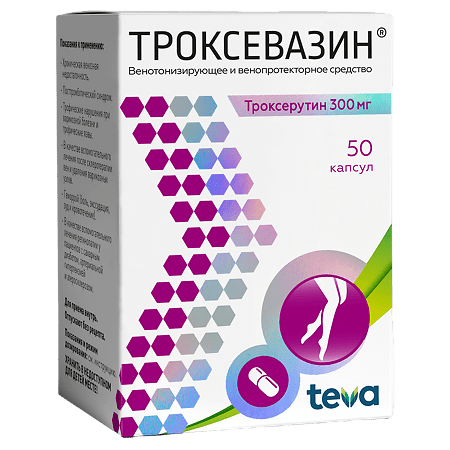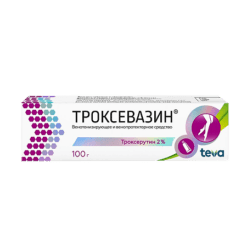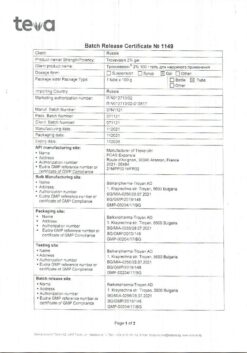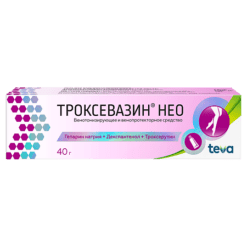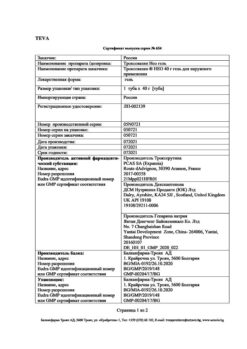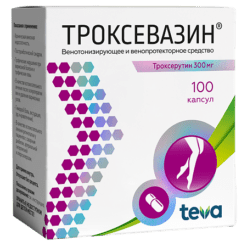No products in the cart.
Troxevasin, capsules 300 mg 50 pcs
€20.96 €17.47
Description
Pharmacotherapeutic group: venotonizing and venoprotective agent
ATX code C05CA04
p> Pharmacological properties
Troxevasin contains at least 95% troxerutin. Troxerutin selectively accumulates in the endothelial layer of the vessels, penetrates deep into the subendothelial layer of the venous wall, creating higher concentrations there than in the surrounding tissues. It prevents damage to cell membranes caused by oxidative reactions. The antioxidant effect is manifested in the prevention and elimination of oxidative properties of oxygen, inhibition of lipid oxidation and protection of the vascular endothelium from the oxidative effects of hydroxyl radicals. Troxerutin reduces the increased permeability of capillaries and has venotonic effect. The cytoprotective effect results from inhibition of activation and adhesion of neutrophils, reduction of erythrocyte aggregation and increase of their resistance to deformation, reduction of release of inflammatory mediators. Troxerutin increases veno-arterial reflux and increases the time of repletion of veins, improves microcirculation and microvascular perfusion.
Troxerutin reduces pathological changes associated with venous insufficiency: swelling, pain, improves tissue trophism.
Interfering the permeability and resistance of capillary walls, troxerutin helps to slow the progression of diabetic retinopathy.
The effect of troxerutin on the rheological properties of the blood helps prevent the development of retinal vascular microthrombosis.
Pharmacokinetics
absorption
. After ingestion of the radioactively labeled drug, absorption of 14C-O-(β-hydroxyethyl)-rutoside in humans is about 10-15%. Maximum plasma concentrations (Cmax) are reached within 1-9 hours. Within 120 hours, concentrations remain detectable; the decrease in concentration is bioexponential.
Distribution
The binding to plasma proteins is 27-29%, in the largest amounts it accumulates in the endothelium. It does not penetrate through the blood-brain barrier. It penetrates insignificantly through the placental barrier and is excreted in minimal quantities with breast milk.
Biotransformation
Metabolized mainly by o-glucuronidation in the liver.
Evolution
Extracted mainly through the intestine and to a lesser extent by the kidneys.
Indications
Indications
– Chronic venous insufficiency.
– Postthrombotic syndrome.
– Trophic disorders in varicose veins and trophic ulcers.
– As an auxiliary treatment after sclerotherapy of veins and removal of varicose veins.
– Hemorrhoids (pain, exudation, itching and bleeding).
– As an adjuvant treatment of retinopathy in patients with diabetes mellitus, arterial hypertension and atherosclerosis.
Pharmacological effect
Pharmacological effect
Pharmacotherapeutic group: venotonic and venoprotective agent
ATX code: C05CA04
Pharmacological properties
Mechanism of action, pharmacodynamic effects
Troxevasin contains at least 95% troxerutin. Troxerutin selectively accumulates in the endothelial layer of blood vessels, penetrates deep into the subendothelial layer of the venous wall, creating higher concentrations there compared to surrounding tissues. Prevents damage to cell membranes caused by oxidative reactions. The antioxidant effect is manifested in the prevention and elimination of the oxidative properties of oxygen, suppression of lipid oxidation and protection of the vascular endothelium from the oxidative effects of hydroxyl radicals. Troxerutin reduces increased capillary permeability and has a venotonic effect. The cytoprotective effect is the result of suppressing the activation and adhesion of neutrophils, reducing the aggregation of erythrocytes and increasing their resistance to deformation, and reducing the release of inflammatory mediators. Troxerutin increases venous-arterial reflux and increases the time of refilling of veins, improves microcirculation and microvascular perfusion.
Troxerutin reduces pathological changes associated with venous insufficiency: swelling, pain, improves tissue trophism.
Due to its effect on the permeability and resistance of capillary walls, troxerutin helps slow the progression of diabetic retinopathy.
The effect of troxerutin on the rheological properties of blood helps prevent the development of retinal vascular microthrombosis.
Pharmacokinetics
Suction
After oral administration of a radioactively labeled drug, the absorption of 14C-O-(β-hydroxyethyl)-rutosides in humans is about 10-15%. The maximum concentration in blood plasma (Cmax) is achieved within 1-9 hours. Within 120 hours, concentrations remain detectable; the decrease in concentration is bioexponential.
Distribution
The connection with blood plasma proteins is 27-29%, and accumulates in the largest quantities in the endothelium. Does not penetrate the blood-brain barrier. It penetrates the placental barrier slightly and is excreted in minimal quantities in breast milk.
Biotransformation
Metabolized mainly through o-glucuronidation in the liver.
Removal
It is excreted mainly through the intestines and to a lesser extent by the kidneys.
Special instructions
Special instructions
When treating superficial thrombophlebitis or deep vein thrombosis, the use of the drug does not exclude the need to prescribe anti-inflammatory and antithrombotic therapy.
Troxerutin is ineffective for edema caused by concomitant diseases of the liver, kidneys and heart.
If during the period of use of the drug the severity of the symptoms of the disease does not decrease or the symptoms of the disease become more severe, you should immediately consult a doctor. There is insufficient experience with the use of the drug in children under 18 years of age. When using the drug independently, you should not exceed the maximum duration and recommended doses.
Impact on the ability to drive vehicles and machinery
Taking the drug does not affect motor and mental reactions, does not interfere with driving vehicles and other complex mechanisms.
Active ingredient
Active ingredient
Troxerutin
Composition
Composition
1 capsule contains:
active ingredient: troxerutin 300.0 mg;
excipients: lactose monohydrate 47.0 mg, magnesium stearate 3.0 mg.
capsule shell: body – quinoline yellow dye (E 104) 0.9%, sunset yellow dye (E 110) 0.039%, titanium dioxide (E 171) 3%, gelatin up to 100%; cap – quinoline yellow dye (E 104) 0.9%, sunset yellow dye (E 110) 0.039%, titanium dioxide (E 171) 3%, gelatin up to 100%.
Pregnancy
Pregnancy
Pregnancy
The use of the drug during the first trimester of pregnancy is contraindicated. The possibility of using the drug during the second and third trimester of pregnancy is determined by the doctor and is possible only if the expected benefit to the mother outweighs the potential risk to the fetus.
If it is necessary to use the drug in the second and third trimesters of pregnancy, you should consult your doctor.
Lactation
It is excreted in minimal quantities in breast milk. The use of the drug during breastfeeding has not been studied.
Contraindications
Contraindications
– Hypersensitivity to troxerutin, rutosides or any of the excipients of the drug.
– Pregnancy (I trimester).
– Peptic ulcer of the stomach and duodenum.
– Chronic gastritis in the acute phase.
– Children under 18 years of age (experience of clinical use is insufficient).
– Breastfeeding period.
– Rare hereditary galactose intolerance, lactase deficiency, glucose-galactose malabsorption syndrome.
With caution
The drug should be used with caution in case of renal failure (with long-term use), during pregnancy (II and III trimesters).
Side Effects
Side Effects
Summary of Adverse Reactions
The frequency of occurrence of adverse reactions is given in accordance with the WHO classification: very often (≥1/10), often (≥1/100, ˂1/10), infrequently (≥1/1000, ˂1/100), rarely (≥1/10000, ˂1/1000), very rarely (˂1/10000), frequency unknown (cannot be estimated based on available data).
Immune system disorders: very rarely – anaphylactic shock, anaphylactoid reactions, hypersensitivity reactions (for example, skin rash).
Nervous system disorders: very rarely – headache, dizziness.
Vascular disorders: very rarely – hyperemia (“flushes” of blood), ecchymosis.
Gastrointestinal disorders: rarely – nausea, pain and discomfort in the stomach, dyspepsia, flatulence, diarrhea, erosive and ulcerative lesions of the gastrointestinal tract.
Skin and subcutaneous tissue disorders: rarely – itching, rash, urticaria.
General disorders and reactions at the injection site: very rarely – feeling of fatigue.
If undesirable reactions occur, you should consult a doctor.
Interaction
Interaction
There are no established drug interactions.
Overdose
Overdose
Symptoms
In case of an overdose, the following symptoms may appear: agitation, nausea, headache, flushing of blood to the face.
Treatment
It is necessary to rinse the stomach, take activated charcoal, and, if necessary, carry out symptomatic treatment.
In case of overdose of the drug, you should immediately consult a doctor.
Storage conditions
Storage conditions
Store at a temperature not exceeding 25 °C.
Keep out of the reach of children!
Shelf life
Shelf life
5 years.
Do not use after expiration date.
Manufacturer
Manufacturer
Balkanpharma-Troyan AD, Bulgaria
Additional information
| Shelf life | 5 years |
|---|---|
| Conditions of storage | In a dry, light-protected place at a temperature not exceeding 25 °C |
| Manufacturer | Balkanpharma – Troyan AD, Bulgaria |
| Medication form | capsules |
| Brand | Balkanpharma – Troyan AD |
Other forms…
Related products
Buy Troxevasin, capsules 300 mg 50 pcs with delivery to USA, UK, Europe and over 120 other countries.

